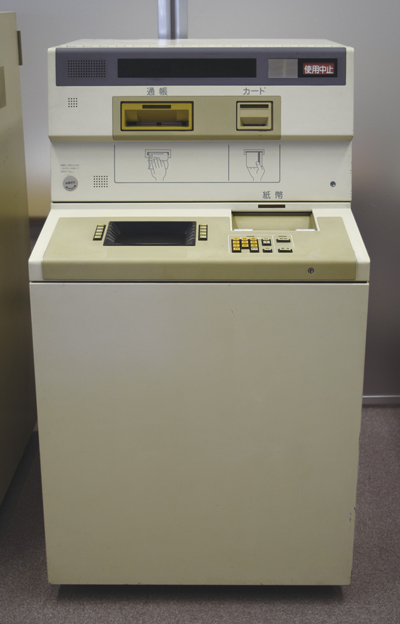

- Home >
- Artifacts of IP Heritage >
- 2014 >
- AT-100
AT-100

| Manufactured in | 1982 |
|---|---|
| Manufactured by | Oki Electric Industry Co., Ltd. |
| Owner | Oki Electric Industry Co., Ltd. |
| Location of historical materials | Oki Electric Industry Co., Ltd. Takasaki Facility, Futaba-cho 3-1, Takasaki-shi, Gunma Prefecture 370-8585, Japan |
| Visitor information | information: Not open to the public (Negotiable. Please ask before visiting) |
| Contact | Takasaki General Affairs Team Tel.+81-27-325-1111 |
In the late 1970s, Japanese ATMs (automated teller machines) were composed of independent deposit and dispensing units. Thus, once the deposit unit reached its capacity or the dispensing unit ran out of banknotes, the entire ATM was removed from service until each unit was emptied or replenished. The challenge, then, was to make the most effective use of the banknotes in the ATM, as the numbers of installed ATMs were increasing.
In 1982, the world’s first cash-recycling ATMs, AT-100, capable of recycling deposits and withdrawals, was launched. The AT-100 was a small footprint unit with a simple banknote opening allowed customers who were unfamiliar to use ATMs, particularly for people with visual impairment, to operate easily while ensuring stable operation regardless of remaining amount of withdrawals.
At that time, making this recycling technology commercially viable required cutting-edge technologies in the areas of hardware mechanisms, controls, and software, as well as high-quality manufacturing technologies. The AT-100 sparked a rapid evolution of mechatronics technologies in Japan.
After the appearance of the AT-100, the cash-recycling ATMs entered the mainstream in Japan. Not only in banks, the cash-recycling ATMs have been widely installed in small-footprint convenience stores. They became part of the essential infrastructure of the Japanese economy backed by around-the-clock cash-handling services.
Now, a cash-recycling ATM is one of the ideal Japanese products, which has the potential to be a global standard.
In 1982, the world’s first cash-recycling ATMs, AT-100, capable of recycling deposits and withdrawals, was launched. The AT-100 was a small footprint unit with a simple banknote opening allowed customers who were unfamiliar to use ATMs, particularly for people with visual impairment, to operate easily while ensuring stable operation regardless of remaining amount of withdrawals.
At that time, making this recycling technology commercially viable required cutting-edge technologies in the areas of hardware mechanisms, controls, and software, as well as high-quality manufacturing technologies. The AT-100 sparked a rapid evolution of mechatronics technologies in Japan.
After the appearance of the AT-100, the cash-recycling ATMs entered the mainstream in Japan. Not only in banks, the cash-recycling ATMs have been widely installed in small-footprint convenience stores. They became part of the essential infrastructure of the Japanese economy backed by around-the-clock cash-handling services.
Now, a cash-recycling ATM is one of the ideal Japanese products, which has the potential to be a global standard.
